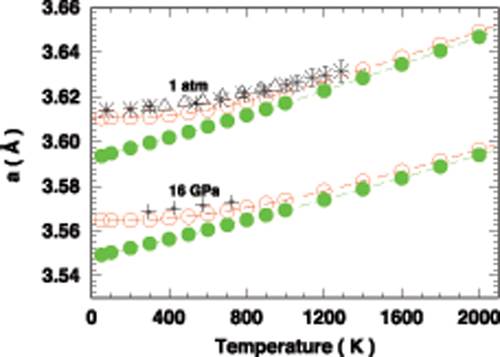Anharmonic quantum effects in cubic boron nitride crystal by path integral Monte Carlo simulations.
BRITO, Braulio G. A.; DASILVA, Linder C.; HAI, Guo-Qiang; CÂNDIDO, Ladir.
BRITO, Braulio G. A.; DASILVA, Linder C.; HAI, Guo-Qiang; CÂNDIDO, Ladir.
 Abstract: Using path-integral Monte Carlo (PIMC) simulations in the isothermal-isobaric ensemble, the authors investigate the quantum effects on structural and thermodynamic properties of cubic boron nitride (c-BN) at pressures varying from 0 up to 162?GPa. The Albe-Tersoff potential is employed to describe the interatomic interactions. The differences between the obtained lattice parameters of the crystal from the PIMC simulation and their experimental values are less than 0.1%. The quantum effects of the atomic zero-point motion are significant for temperature lower than 1000?K. At ambient pressure, the quantum contribution to the lattice vibrational energy overcomes the classical one for ???386 ?K. This temperature dependent crossover shifts to higher temperature with increasing pressure. The ratio of the kinetic to potential vibrational energy is used to quantify the anharmonicity of the system, indicating that the c-BN is essentially an anharmonic crystal. Furthermore, the root-mean-square displacement (RMSD) analysis shows that the quantum effects become insignificant for temperature higher than 1000?K where different atoms (boron and nitrogen) behave similarly. However, for lower temperatures, the quantum effects arise and the atoms have quite different behaviors resembling those from rare-gas solids (boron) and covalent materials (nitrogen). Abstract: Using path-integral Monte Carlo (PIMC) simulations in the isothermal-isobaric ensemble, the authors investigate the quantum effects on structural and thermodynamic properties of cubic boron nitride (c-BN) at pressures varying from 0 up to 162?GPa. The Albe-Tersoff potential is employed to describe the interatomic interactions. The differences between the obtained lattice parameters of the crystal from the PIMC simulation and their experimental values are less than 0.1%. The quantum effects of the atomic zero-point motion are significant for temperature lower than 1000?K. At ambient pressure, the quantum contribution to the lattice vibrational energy overcomes the classical one for ???386 ?K. This temperature dependent crossover shifts to higher temperature with increasing pressure. The ratio of the kinetic to potential vibrational energy is used to quantify the anharmonicity of the system, indicating that the c-BN is essentially an anharmonic crystal. Furthermore, the root-mean-square displacement (RMSD) analysis shows that the quantum effects become insignificant for temperature higher than 1000?K where different atoms (boron and nitrogen) behave similarly. However, for lower temperatures, the quantum effects arise and the atoms have quite different behaviors resembling those from rare-gas solids (boron) and covalent materials (nitrogen). | |
| Physica Status Solidi B |
| v. 149, n. 21, p. 214303-1-214303-9 - Ano: 2019 |
| Fator de Impacto: 1,454 |
| http://dx.doi.org/10.1002/pssb.201900164 |  @article={002951194,author = {BRITO, Braulio G. A.; DASILVA, Linder C.; HAI, Guo-Qiang; CÂNDIDO, Ladir.},title={Anharmonic quantum effects in cubic boron nitride crystal by path integral Monte Carlo simulations},journal={Physica Status Solidi B},note={v. 149, n. 21, p. 214303-1-214303-9},year={2019}} @article={002951194,author = {BRITO, Braulio G. A.; DASILVA, Linder C.; HAI, Guo-Qiang; CÂNDIDO, Ladir.},title={Anharmonic quantum effects in cubic boron nitride crystal by path integral Monte Carlo simulations},journal={Physica Status Solidi B},note={v. 149, n. 21, p. 214303-1-214303-9},year={2019}} |



